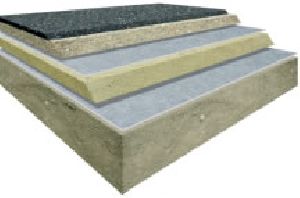
Non Woven Geotextiles
Introduction: Non-Woven Geotextile are needle punched fabrics made from polypropylene. The dry laid needle punch technology is based on a two step process. Firstly, polypropylene resin is extruded into fibres. Secondly, the fibres are carded and needlepunched. Finally, some types are added thermal treatment. Weights range from 100 g/m2 up to 1200 g/m2. Functions of Non-Woven Geotextile: Primary Functions: Separation The durability and mechanical properties of Non-Woven Geotextiles make them ideal as separating layers in construction works. To prevent mixing of construction layers. To improve the compaction properties of the aggregate layer. To increase bearing capacity by avoiding material loss into the subgrade. To provide long-term stability of foundation layers. Filtration The characteristic opening size of Non-Woven Geotextiles is designed to retain particles while allowing free movement of water, making it possible to separate two layers during intense hydraulic activity. To avoid migration of fine material into coarse material as a result of water flow in the soil. To maintain the water flow in the soil with minimum pressure loss. To prevent migration of fine material as a result of pump effects from dynamic loads such as traffic. Protection When placing a Non-Woven Geotextile on both sides of a waterproof membrane, the thickness and strength of the geotextile protect the membrane from puncture. To ensure the integrity of a sealing material when fill material and/or loads are applied. To protect a membrane and at the same time, drain water in its plane. Secondary Function: Drainage Excess water is drained off the construction - not by passing through the Non-Woven Geotextile as when used for filtration - but by flowing in the plane of the geotextile leading it away from the construction. To ensure that water and/or other fluids are drained with minimum pressure loss. To ensure an ongoing drainage.
Color : Grey, White
Material : Polypropylene, Polyester
Application : Reinforcement, Drainage, Separation,Used to separate two layers of soil in construction work.
Thickness : 0.9 mm to 3.6 mm
...more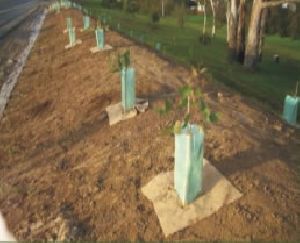
Mulch Mats
Introduction: The Jute Coir mulch mat can be used anywhere for control of weeds around a newly planted sapling. The Jute-Coir nonwoven cuts supply of sunlight to the ground and prevents growth of weeds. Being bio-degradable it decomposes over time to form humus and further helps in the plant's growth. It can absorb and retain water up to 5 times its own weight. It also absorbs and retains nutrients and fertilizers applied to the sapling. The mulch mat controls temperature of the soil below it and saves the plant from extreme heat or cold, thus increasing. Application: Forestation projects, Plantations, Orchards requiring mulching and weed control, Sides of Runways, Factories, Railway and Container yards requiring weed control.
Color : Brown
Material : Coir
Thickness : 0.5 INCHES
Application : Agriculture
Feature : Biodegradable, Suitable for nurseries
...more
Jute Geo Textile
Introduction: Jute Geotextile is a kind of natural technical product, laid in or on soil to improve its engineering properties. Jute soil savers dissipate kinetic energy of raindrops and control surface runoff. They also help in precipitation of detached soil particles and aid in faster growth of vegetation. They absorb water up to 5 times their own weight. They degrade faster and so are used in areas conducive to growth of vegetation. They are cheap compared to coir products. Application: Approach roads of bridges. Overburden dumps of open cast mines. Watershed and Ecology management. Slopes of Roads, Railways, Flood embankments and on hill slopes. Erosion Control in golf courses. Products Weight gm/sqm Thickness (mm) Width(m) Jute Geotextiles can be used in the construction of temporary and access roads. They perform filtration, separation and drainage functions for 6 to 12 months and degrade without leaving any harmful residue. The inherent drainage property of natural fibres to carry water in the plane direction can be advantageously used to increase the bearing capacity of the soil by draining away water and hence stiffening the soil. Jute geotextiles are used as silt fences in short duration projects because of their filtration property. They are eco-friendly and can be disposed without any treatment or precautions. Jute geotextiles find application as night cover on waste dumps. After use they can either be disposed in the landfill or composted into a fertilizer.
Material : 100% Jute Fibers
Application : Approach Roads of Bridges, Overburden Dumps of Open Cast Mines.
...more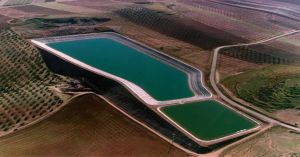
Geomembranes
Geomembranes are manufactured using high density polyethylene (HDPE). These are of various thicknesses and with either smooth or textured surfaces (for steeper slopes). The product is suitable for sealing landfill caps and base liners, secondary containment, potable water and non-toxic containment applications such as water conveyance structures, canals or ponds.
Material : HDPE
Length : 150 -200 M
Color : Black, Brown
Application : Landfill Liners
Thickness : 0.100 to 0.600 Micron
Application : Water Pond, Construction
...more
Geogrids
Introduction: Geogrids are polymeric products formed by joining intersecting ribs. They have large open spaces known as "apertures". The directions of the ribs are referred to as machine direction (md), orientated in the direction of the manufacturing process or cross machine direction (cmd) perpendicular to the machine direction ribs. Geogrids are mainly made from polymeric materials, typically polypropylene (PP), high density polyethylene (HDPE) and polyester (PET). Geogrids are manufactured as either biaxial or uniaxial. Biaxial geogrids are those that exhibit the same strength in both the machine and cross machine directions while uniaxial geogrids exhibit the primary strength in the machine direction with minimal strength, enough to maintain the aperture structure, in the cross machine direction. Function of Geogrid: Basic function of Geogrid is soil reinforcement. Geogrids work by interlocking with the granular or soil material placed over them. Reinforcement: The mechanical properties of Geogrids, make them ideal for reinforcing slopes and other soil structures. To avoid collapse of vertical soil walls or steep soil slopes. To avoid rutting when dealing with poor subsoils.
Material : Hdpe
Length : As Per Requirements
Application : Railway, Highway, Slope protection, Airport, Bridge
Condition : Modern
Finishing : Polished
Feature : Durable, Hard Structure
Design Type : Customized
...more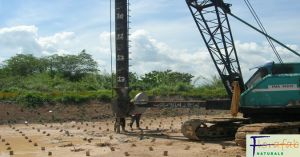
floradrain
Introduction: Clay soil has a low permeability and hence pore water trapped in the soil cannot come out in a short time period. Floradrain (FFD-8) prefabricated drain can be installed vertically to depths as great as 40 m. Water, under pressure in excess of hydrostatic pressure, flows through the Jute filter sheath and into the core coir channels where it is led vertically out of the soil. This may be either up or down to intersecting natural layers or to the surface where a sand drainage blanket or Jute-coir prefabricated strip drains are provided. The water in the soil has to travel the distance to the nearest drain to reach a free drainage path. The drains are usually placed in a triangular configuration of 1 to 10 metres - depending on the desired consolidation time. As a result of this method of accelerating the consolidation process, uneven post-construction settlements can be virtually eliminated. Application: Accelerated settlement and consolidation of construction over soft soil like Road Rail embankments, underwater constructions, Foundations for tank farms and material storage areas, Land Reclamation etc.
Width : 80-100 mm
Thickness : 8 mm
Tensile Strength : >10 Kn/m
...more
Drainage Composite
Introduction: Drainage composites are made by combining two or more geosynthetic materials to achieve multiple functions like Filtration - Drainage, Filtration – Separation- Drainage, Filtration – Separation – Drainage – Protection Filtration – Separation – Drainage – Protection - Impermeability These are highly robust which allows them to withstand high degree of stress during installation, it adapts perfectly to uneven surfaces due to its light and flexible make and are easy to transport and store. These drainage composites are long-lasting as they are imperishable, chemically inert, resistant to microorganism, resistant to oxidization, insensitive to atmospheric agents, insensitive to salt water etc. These usually comes as drainage nets which are both biaxial and triaxial, both these net comes with geotextile on one side, on both sides, geotextile on one side and impermeable membrane on the other side, which act as waterproofing material. Functions of Drainage Composites Primary Function Drainage High drainage capacity, even on minimum slopes and when subjected to high loads. Secondary Function Protection Provide effective protection to waterproof membranes or impermeable liners. Filtration Filters liquids perfectly, preventing passing of fines. Prevents silting of collector pipe. Impermeability Provide waterproofing in underpasses, Cut and Cover Tunnels, Concrete walls and Roof Gardens. Separation Provide effective Separation between dissimilar soil layers.
Features : Provides positive drainage, Easily placed, High compressive strength
Applications : Gas venting and gas monitoring vents, Underground cut off curtains
Thickness : 8 mm to 10 mm
...more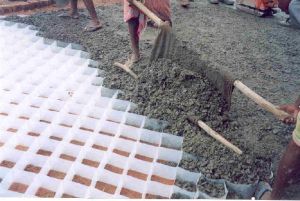
Concrecell
Concrecell is a cellular honeycomb like structural formwork, manufactured from slit film strips that are joined to, form three dimensional cells. Concrecell is used as: in-situ formwork to cast continuous, 3D-interlocking concrete paving for road or canal construction. an erosion control formwork for concrete or vegetated soil embankment. Advantages Equivalent Elastic Modulus of 100 mm thick cast in-situ blocks is equal to 136 mm of high strength Bituminous concrete. Can be laid to very steep grades. Provides a concrete shuttering and finished height profile. Concrete infill has built in joints. Controlled Cracking Concrete infill has built in joints which are very thin. No mud pumping Storm water side drain can be cast integral with road Built in skid Resistance Steel Reinforcement is not required, hence cost effective. Lasts longer than flexible Pavements, Is maintenance free.
Shape : Honeycomb
Feature : 3d-interlocking Concrete Paving for Road or Canal Construction
...more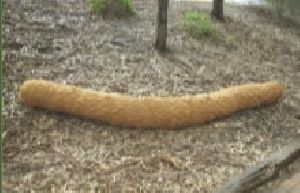
coconut coir logs
Introduction: COIR LOGS are made from coconut fibers bound together with biodegradable netting. Florafab coir gabions are either cylindrical or cuboid in shape, they can be made to various lengths and diameters as per site requirement. Application: Stream bank restoration, wetland environment creation. Provides a substrate for plant growth. Protects from wave erosion. Wave energy absorber. Serves as transition from one re-vegetation technique to another. Secure the toe of a slope. Act as a facia to a geogrid wrap around soil wall.
Diameter : 10 cm to 25 cm
Size : Maximum width 220mm to 600mm
Color : Brown
...more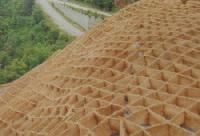
Coir Geocells
On steep barren slopes it is difficult to place top soil. CoirGeo-cell is 15cm wideband of tightly woven coir geo-textile bound in a honeycomb cell like structure. They are laid on steep slopes using steel pins or natural. The honey comb shaped structure can then be filled with soil and saplings planted in them. Applications: Lining canals and ash ponds. Stabilization steep stream banks and embankments. Confining topsoil on steep barren slopes. Sustaining vegetation and controlling soil erosion on steep slopes.
Length : 10 Mtrs To 50 Mtrs.
Color : Brown & Natural
Width : 2 Mtr. To 4 Mtr
Thickness : 5 mm
Application : Used in Sub grade Stabilization, Erosion control filter
...more
Erosion Control Coir Blankets
Introduction: Coir erosion control blanket can be either woven or non-woven. Woven ECB is an open weave structure with large / small open mesh. Non-woven ECB is either needle punched or stitch bonded.These materials are useful in erosion control and re-vegetation on slopes less than 50 degrees or in channels, where water flow rates are between 1 and 4 m/s. The hairy nature of the yarn used for making the blanket breaks the falling raindrop into droplets, thus decreasing their erosive action. The material absorbs water, around 3 times its own weight. Coir geotextile lasts for 3 to 5 years and degrades to form humus which is useful for plant growth. Application: Erosion control and slope stabilization of Hill Sides-Ski Slope. Protection of High embankments of Road, Railway, Water Reservoir Facia in reinforced earth slopes. Protection of River and Canal Embankments, Wave Energy Absorber. Creation and Protection of Dunes. Wind erosion Control. Re-vegetation and forestation projects. Restoration of ecology, wetland areas, degraded lands, landslide areas. As eco-friendly night covers in waste dumps. Landscaping Waste Dump Areas. Protects geosynthetic installations from exposure to UV and vandalism.
Material : Coir
Feature : Long Life
Application : Erosion Control, Seed Germination
Length : Customized
Color : Brown or Golden Brown
...more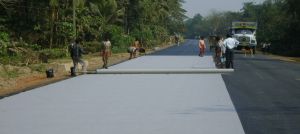
ASPHALT OVERLAY PAVING FABRIC
Introduction: Paving fabrics are widely used in both new road constructions and in road maintenance to reduce reflective cracking in the pavement. The purpose is to distribute stresses originated from cracks in the lower part of the pavement by creating a stress relieving and/or waterproofing interlayer membrane system. Paving fabrics made from polypropylene fibres is a flexiblepre-compressed needle punched nonwoven fabric added thermal bonding on one side only. To avoid reflective cracking of new asphalt. To protect the subsoil from water intrusion and thereby loss of bearing capacity.
Thickness : 1-1.5 inch
Feature : Hold asphalt cement tack coat, Reduces reflective cracking in the pavement
Usage : New road constructions as well as in maintenance of roads to reduce reflective cracking in pavements
...moreBe first to Rate
Rate This